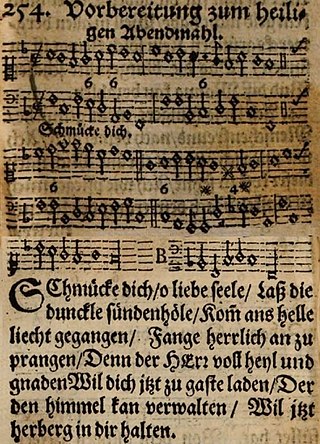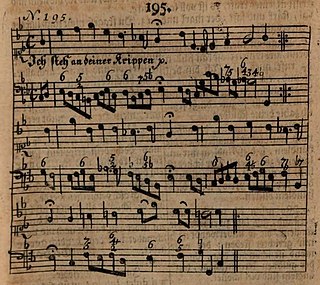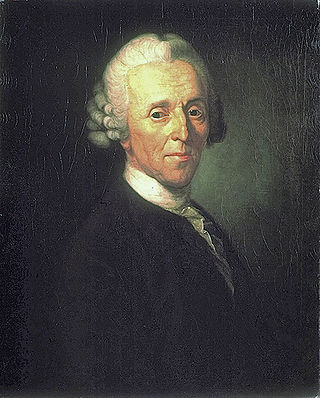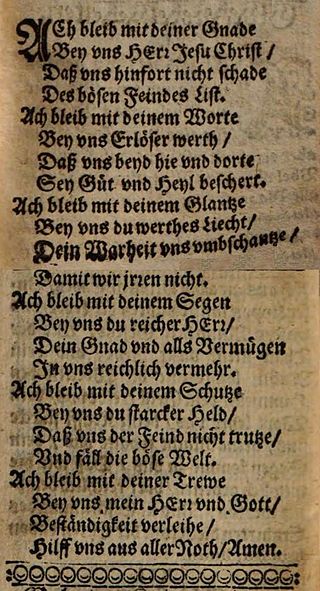Related Research Articles

"Wer weiß, wie nahe mir mein Ende" is a Lutheran hymn in German with lyrics by Ämilie Juliane von Schwarzburg-Rudolstadt, written in 1686. The hymn reflects the preparation for a good death. It is sung to the melody of "Wer nur den lieben Gott läßt walten", and is often used for funerals. It appears in the current German Protestant hymnal Evangelisches Gesangbuch (EG), but with a different melody.

Nikolaus Herman was a German Lutheran cantor and teacher, creating numerous Protestant hymns. Some of them are contained in hymnals in several languages.

"Mit Fried und Freud ich fahr dahin" is a hymn by Martin Luther, a paraphrase in German of the Nunc dimittis, the canticle of Simeon. Luther wrote the text and melody, Zahn No. 3986, in 1524 and it was first published in the same year. Originally a song for Purification, it has been used for funerals. Luther included it in 1542 in Christliche Geseng ... zum Begrebniss.
"Jesus Christus, unser Heiland, der von uns den Gotteszorn wandt" is a Lutheran hymn in ten stanzas by Martin Luther for communion, first published in 1524 in the Erfurt Enchiridion. It is one of Luther's hymns which he wrote to strengthen his concepts of reformation. The models for the text and the melody of Luther's hymn existed in early 15th-century Bohemia. The text of the earlier hymn, "Jesus Christus nostra salus", goes back to the late 14th century. That hymn was embedded in a Hussite tradition.

"Christ unser Herr zum Jordan kam" is a Lutheran hymn about baptism by Martin Luther, written in 1541 and published in 1543. It has been set in many musical compositions, including cantatas and chorale preludes by Johann Sebastian Bach.
Bartholomäus Gesius was a German theologian, church musician, composer and hymn writer. He worked at Schloss Muskau and in Frankfurt (Oder) and is known for choral Passions in German and Latin and for the melody and first setting of the Easter hymn "Heut triumphieret Gottes Sohn", which was used in several compositions including a cantata by Dieterich Buxtehude and a chorale prelude by Johann Sebastian Bach, concluding the Easter section of his Orgelbüchlein.

"Heut triumphieret Gottes Sohn" is a Lutheran hymn for Easter. Kaspar Stolzhagen published the hymn in 1592, and its setting by Bartholomäus Gesius was published in 1601. The hymn was adopted in several hymnals, including the Evangelisches Gesangbuch. Composers such as Johann Sebastian Bach based compositions on its hymn tune.

"Schmücke dich, o liebe Seele" is a Lutheran hymn in German, with lyrics by Johann Franck and a hymn tune by Johann Crüger. It was first published in Crüger's 1649 Geistliche Kirchen-Melodien, and was later adopted in other hymnals, such as the 1653 edition of his Praxis pietatis melica.

"Was mein Gott will, das g'scheh allzeit" is a Lutheran hymn in German. The text from c. 1550 is attributed to Albert, Duke of Prussia. The melody, Zahn No. 7568, goes back to a tune by Claudin de Sermisy, written in 1529 for a secular French song. The hymn has belonged to core Lutheran hymnody without interruption and is part of the Protestant hymnal Evangelisches Gesangbuch as EG 364.

"Christus, der uns selig macht" is a German Lutheran Passion hymn in eight stanzas in German by Michael Weiße, written in 1531 as a translation of the Latin hymn "Patris Sapientia" to an older melody of the Bohemian Brethren.

"Da der Herr Christ zu Tische saß" is a Christian hymn related to the Passion of Jesus. The 28 stanza text was written by Nikolaus Herman and first published in 1560. Later Johann Sebastian Bach composed the four-part setting, BWV 285.

"Ich will dich lieben, meine Stärke" is a sacred poem by Johann Scheffler who is known by his pen name Angelus Silesius. It appeared first in a poem collection, Heilige Seelen-Lust in 1657, and has become a Christian song in notable hymnals of different denominations, with different melodies.

"Ich steh an deiner Krippen hier" is a German Christmas hymn, with lyrics by Paul Gerhardt which were first published in 1653. It was then sung with an older melody by Martin Luther, but a melody which was likely created by Johann Sebastian Bach for Schemellis Gesangbuch of 1736 is now part of current Protestant and Catholic hymnals.
Georg Grünwald, also Grüenwald, was a German Protestant reformer and hymn writer.

"Lobet den Herren alle, die ihn ehren" is a sacred morning song with a text by Paul Gerhardt and a melody by Johann Crüger, who first published it in the fifth edition of his hymnal Praxis pietatis melica in 1653. The Lutheran hymn is still popular and appears in hymnals including the Protestant Evangelisches Gesangbuch and the Catholic Gotteslob.
"Einer ist unser Leben" is a poem in five stanzas, written by Lothar Zenetti in 1973. It became a Christian hymn of the genre Neues Geistliches Lied (NGL) with a 1971 melody by Jean Liesse. The song is part of many hymnals, both Catholic and Protestant, and of songbooks, remaining popular in the 21st century.
"Morgenglanz der Ewigkeit" is a Christian hymn with German text originally by Christian Knorr von Rosenroth, written around 1690 and set to music for private devotion. It became known with a 1662 melody by Johann Rudolf Ahle. The song is part of modern German hymnals and songbooks. It was translated to English as "Come, Thou Bright and Morning Star", and as "Dayspring of Eternity".

"Herr, stärke mich, dein Leiden zu bedenken" is a Passion hymn in German, written by Christian Fürchtegott Gellert to the melody of "Herzliebster Jesu", and first published in 1757. It is contained in the German Protestant hymnal Evangelisches Gesangbuch.
"O komm, du Geist der Wahrheit" is a Lutheran hymn for Pentecost in German. The text was written by Philipp Spitta, probably in 1827, and published in 1833 in the song collection Psalter und Harfe. It is a prayer to the Holy Spirit for courage to confession in a time poor in faith. The hymn which first appeared without a melody, is now usually sung to the 1529 melody of "Lob Gott getrost mit Singen". It is part of the current Protestant hymnal, and of other hymnals.

"Ach bleib mit deiner Gnade" is a hymn with text by Josua Stegmann" written in 1627. The melody is taken from "Christus, der ist mein Leben", a 1609 song by Melchior Vulpius that became one of the key melodies in Protestant hymnody. It is part of several current hymnals, the Protestant Evangelisches Gesangbuch as EG 347, the Catholic Gotteslob as GL 436 and the Mennonitisches Gesangbuch as MG 149. It belongs to the ecumenical hymns.
References
- 1 2 3 4 "Mir nach, spricht Christus, unser Held". evangeliums.net (in German). Archived from the original on 5 June 2023. Retrieved 24 September 2023.
- 1 2 3 "Mir nach, spricht Christus, unser Held". hymnary.org. Archived from the original on 1 April 2022. Retrieved 24 September 2023.
- ↑ "Mir nach, spricht Christus, unser Held". liederdatenbank.de (in German). Archived from the original on 15 August 2022. Retrieved 24 September 2023.
- 1 2 3 4 Fischer, Michael (2007). "Mir nach spricht Christus". Liederlexikon (in German). Archived from the original on 9 October 2023. Retrieved 1 October 2023.
- ↑ BWV 245.22 bach-chorales.com